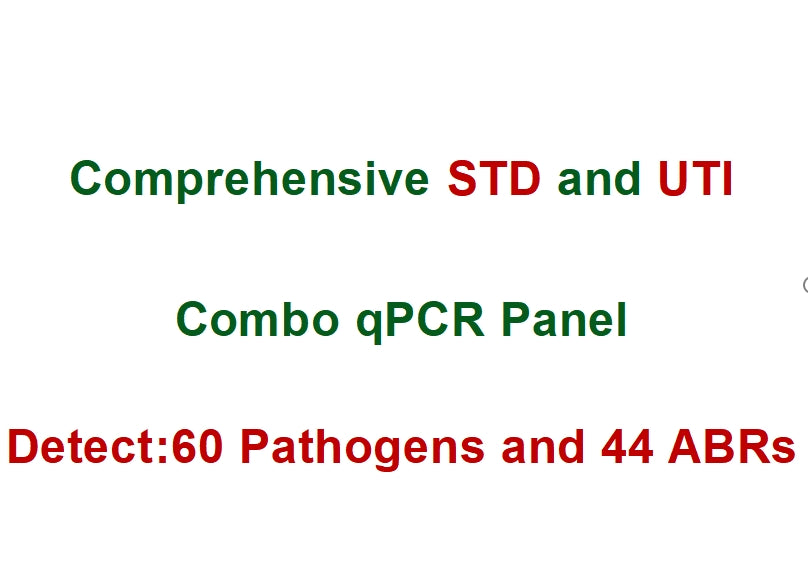Comprehensive STD and UTI Combo qPCR Panels
Comprehensive STD and UTI Combo qPCR Panels
Couldn't load pickup availability
Comprehensive STD and UTI Combo qPCR Panel
This all-in-one molecular panel integrates two powerful diagnostic tools—STD and UTI qPCR assays—into a single, highly efficient solution. The panel is designed to detect a total of 60 pathogens, including 19 viruses, 33 bacteria, 7 fungi, and 1 protozoan, along with 44 antibiotic resistance (ABR) genes. It supports faster, more precise diagnosis from a single specimen, ideal for overlapping urogenital symptoms often seen in clinical settings.
Why Combine STD and UTI Testing?
Sexually transmitted infections (STIs) and urinary tract infections (UTIs) frequently share similar symptoms, such as:
• Burning sensation during urination
• Increased urinary frequency or urgency
• Pelvic or abdominal discomfort
• Abnormal discharge
Because these symptoms can overlap, clinical diagnosis without lab confirmation can lead to misdiagnosis or delayed treatment. This combo panel ensures comprehensive detection, improving diagnostic confidence and patient outcomes.
Key Benefits
• One-sample, dual-detection workflow for STIs and UTIs
• Results available within 24 hours of sample receipt
• High sensitivity and specificity through real-time qPCR
• Supports antimicrobial stewardship via resistance gene detection
• Enhances diagnostic clarity and reduces treatment delays
This panel is well-suited for urgent care, primary care, OB/GYN, and urology practices where prompt and actionable diagnostics are essential.
Detected Pathogens and Resistance Genes
Viruses (19)
• Human Herpesvirus 5 (HHV-5 – Cytomegalovirus)
• Herpes Simplex Virus 1 (HSV-1)
• Herpes Simplex Virus 2 (HSV-2)
• HPV 16
• HPV 18
• HPV 45
• HPV 33
• HPV 58
• HPV 31
• HPV 52
• HPV 39
• HPV 56
• HPV 68
• HPV 06
• HPV 11
• HPV 35
• HPV 51
• HPV 66
• HPV 59
Bacteria (33)
• Escherichia coli
• Klebsiella pneumoniae
• Klebsiella oxytoca
• Proteus vulgaris
• Pseudomonas aeruginosa
• Serratia marcescens
• Citrobacter freundii
• Citrobacter koseri
• Enterobacter aerogenes (Klebsiella aerogenes)
• Enterobacter cloacae
• Morganella morganii
• Providencia stuartii
• Staphylococcus aureus
• Staphylococcus epidermidis
• Staphylococcus saprophyticus
• Streptococcus pyogenes (Group A)
• Streptococcus agalactiae (Group B)
• Streptococcus gallolyticus subsp. pasteurianus
• Viridans Group Streptococci
• Corynebacterium riegelii
• Corynebacterium urealyticum
• Actinotignum schaalii
• Aerococcus urinae
• Alloscardovia omnicolens
• Gardnerella vaginalis
• Mycobacterium tuberculosis
• Chlamydia trachomatis
• Neisseria gonorrhoeae
• Mycoplasma genitalium
• Mycoplasma hominis
• Ureaplasma parvum
• Ureaplasma urealyticum
• Treponema pallidum
Fungi (7, Candida species)
• Candida albicans
• Candida auris
• Candida glabrata
• Candida parapsilosis
• Candida tropicalis
• Candida kruseii (Pichia kudriavzevii)
• Candida lusitaniae (Clavispora lusitaniae)
Protozoa (1)
• Trichomonas vaginalis
44 Antibiotic Resistance Genes (ABRs)
blaACC: Acinetobacter-derived cephalosporinase
blaACT: AmpC-type cephalosporinase
blaCMY: Citrobacter freundii-derived AmpC-type beta-lactamase
blaLAT: Latent AmpC-type beta-lactamase
blaFOX: Cephamycin-hydrolyzing AmpC beta-lactamase
blaGES: Guiana extended-spectrum beta-lactamase
blaMIR: Morganella morganii-inducible cephalosporinase
blaVIM: Verona integron-encoded metallo-beta-lactamase
Cfr: Chloramphenicol-florfenicol resistance methyltransferase
CMY/MOX/DHA: AmpC-type beta-lactamases (CMY, MOX, DHA families)
CTX-M_1: Cefotaximase-Munich beta-lactamase group 1
CTX-M_2: Cefotaximase-Munich beta-lactamase group 2
CTX-M_8_25: Cefotaximase-Munich beta-lactamase groups 8 and 25
CTX-M_9: Cefotaximase-Munich beta-lactamase group 9
dfrA1: Trimethoprim-resistant dihydrofolate reductase type A1
dfrA5: Trimethoprim-resistant dihydrofolate reductase type A5
ermA: Erythromycin ribosome methylation A gene
ErmB: Erythromycin ribosome methylation B gene
ErmC: Erythromycin ribosome methylation C gene
IMP-1: Imipenemase metallo-beta-lactamase type 1
IMP-2: Imipenemase metallo-beta-lactamase type 2
KPC: Klebsiella pneumoniae carbapenemase
MCR-1: Mobile colistin resistance gene 1
MecA: Methicillin resistance gene A
MecC: Methicillin resistance gene C
mefA: Macrolide efflux gene A
NDM: New Delhi metallo-beta-lactamase
OXA-48: Oxacillinase-48 carbapenemase
OXA-51: Oxacillinase-51 carbapenemase (Acinetobacter)
PER-1: Pseudomonas extended resistance beta-lactamase
qnrA: Quinolone resistance protein A
QnrB_1of4: Quinolone resistance protein B (variant 1 of 4)
QnrB_2of4: Quinolone resistance protein B (variant 2 of 4)
QnrB_3of4: Quinolone resistance protein B (variant 3 of 4)
QnrB_4of4: Quinolone resistance protein B (variant 4 of 4)
qnrS: Quinolone resistance protein S
SHV: Sulfhydryl variable beta-lactamase
Sul1: Sulfonamide resistance gene 1
Sul2: Sulfonamide resistance gene 2
Tet(M): Tetracycline resistance protein M
Tet(S): Tetracycline resistance protein S
vanA2: Vancomycin resistance gene cluster A2
vanB: Vancomycin resistance gene cluster B
VEB: Vietnamese extended-spectrum beta-lactamase
Share
files/STDUTI.jpg
04:35 AM


